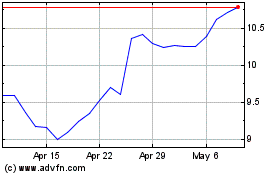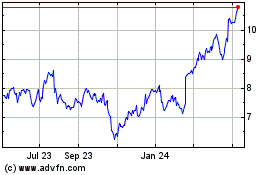Lehman to Pay Another $2.8 Billion to Creditors
June 09 2016 - 1:20PM
Dow Jones News
The team winding down Lehman Brothers Holdings Inc. said
Thursday it would be paying out $2.8 billion to creditors next
week, more than 7 1/2 years after the investment bank's collapse
triggered the financial crisis.
The distribution, the 10th since the investment bank failed in
2008, will bring the total payout in the firm's bankruptcy to more
than $109.9 billion. The bulk of the cash—$80.5 billion—has gone to
pay so-called third-party, or non-Lehman claims.
Most of the latest payout, some $1.5 billion, is coming from a
bankruptcy settlement between Lehman and J.P. Morgan Chase &
Co. The deal, announced in January, resolved the bulk of Lehman's
$8.6 billion lawsuit that claimed J.P. Morgan illegally siphoned
billions of dollars from the foundering investment bank before its
collapse.
Lehman officials sought special court permission to distribute
the cash, which was delayed following the appeal of the
settlement.
Lehman said Thursday in a filing in U.S. Bankruptcy Court in New
York that its general unsecured creditors, who were estimated to
receive less than 20 cents on the dollar when Lehman's bankruptcy
plan went into effect in early 2012, will have recovered nearly 38
cents on the dollar after the next distribution is completed.
The chapter 11 payment plan for Lehman treats similarly situated
creditors of its subsidiaries better than those of the parent. For
example, general unsecured creditors of Lehman's Special Finance
unit, the heart of the failed investment bank's derivatives
business, have so far recovered more than 36 cents on the dollar,
though they are limited to how much they can claim.
General unsecured creditors of Lehman's commodities unit,
meanwhile, will have received more than 78 cents on the dollar
following the latest distribution. The boost in recoveries has come
from gains in the estate's real estate, derivatives and
private-equity investments, Lehman has said.
For the unsecured creditors, among them a number of hedge funds
such as Paulson & Co. that spent the years after Lehman's
collapse buying up bankruptcy claims at steep discounts, the
increased recoveries are adding hundreds of millions in profits
already booked.
Lehman, once the nation's fourth-largest investment bank,
collapsed into the largest bankruptcy ever in September 2008 and
its U.S. brokerage business was quickly sold off to Barclays
PLC.
After the bank failed, some creditors bailed out, not wanting to
wait for their money or to take a chance they wouldn't get paid at
all. Hedge funds were willing buyers of their claims at steep
discounts, betting they would gain in value after the initial panic
subsided.
That bet has become fruitful. Since the bankruptcy, Lehman has
consistently increased estimates of how much creditors would get
back, helping hedge-fund managers such as Paulson and Elliott
Management Corp. rake in big profits.
A team of bankruptcy professionals under the direction of
turnaround firm Alvarez & Marsal managed the New York holding
company's assets until Lehman's exit from bankruptcy in 2012, when
a reorganized company emerged, overseen by a new board of
directors.
Because Lehman still has about $7 billion in remaining
investments to unwind and more money to pay creditors, the bank is
expected to exist in some form for several more years. Lehman plans
to make an 11th distribution at the end of September.
Write to Patrick Fitzgerald at patrick.fitzgerald@wsj.com
(END) Dow Jones Newswires
June 09, 2016 13:05 ET (17:05 GMT)
Copyright (c) 2016 Dow Jones & Company, Inc.
Barclays (NYSE:BCS)
Historical Stock Chart
From Mar 2024 to Apr 2024

Barclays (NYSE:BCS)
Historical Stock Chart
From Apr 2023 to Apr 2024
